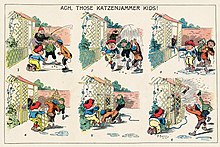A comic strip is a sequence of cartoons, arranged in interrelated panels to display brief humor or form a narrative, often serialized, with text in balloons and captions. Traditionally, throughout the 20th and into the 21st century, these have been published in newspapers and magazines, with daily horizontal strips printed in black-and-white in newspapers, while Sunday papers offered longer sequences in special color comics sections. With the advent of the internet, online comic strips began to appear as webcomics.

Max and Moritz: A Story of Seven Boyish Pranks is a German language illustrated story in verse. It was written and illustrated by Wilhelm Busch and published in 1865, and has since had significant cultural impact, both in German-speaking countries, where the story has been passed down through generations, but on the wider world, after translation into many languages. It has been adapted for film and television, as well as inspiring comic strips and children's TV characters and having things named after it.

King Features Syndicate, Inc. is an American content distribution and animation studio, consumer product licensing and print syndication company owned by Hearst Communications that distributes about 150 comic strips, newspaper columns, editorial cartoons, puzzles, and games to nearly 5,000 newspapers worldwide. King Features Syndicate also produces intellectual properties, develops new content and franchises, like The Cuphead Show!, which it produced with Netflix, and licenses its classic characters and properties.
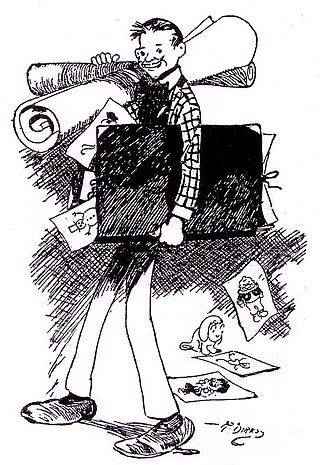
Rudolph Dirks was one of the earliest and most noted comic strip artists, well known for The Katzenjammer Kids.
Ace Comics was a comic book series published by David McKay Publications between 1937 and 1949 — starting just before the Golden Age of Comic Books. The title reprinted syndicated newspaper strips owned by King Features Syndicate, following the successful formula of a mix of adventure and humor strips introduced by McKay in their King Comics title in April 1936; some of the strips were transferred from King Comics and continued in Ace Comics from issue #1. Ace Comics #11, the first appearance of The Phantom, is regarded by many to be a key issue in the history of comics, as it introduced to the comics format one of the first of the costumed heroes, leading to the Golden Age of superheroes in comics.
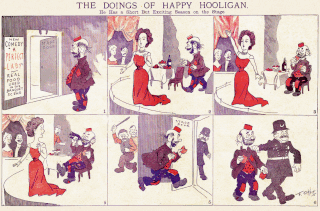
Happy Hooligan is an American comic strip, the first major strip by the already celebrated cartoonist Frederick Burr Opper. It debuted with a Sunday strip on March 11, 1900 in the William Randolph Hearst newspapers, and was one of the first popular comics with King Features Syndicate. The strip ran for three decades, ending on August 14, 1932.
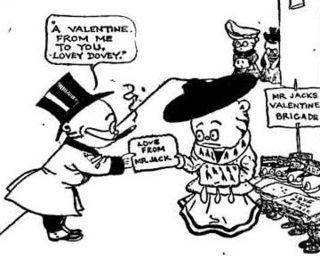
Mr. Jack is an American comic strip by Jimmy Swinnerton which ran in William Randolph Hearst newspapers from August 30, 1903 until 1935. Mr. Jack, a philandering playboy tiger, may be the first developed cartoon animal character, a type that has since become a staple in the comics medium.

Archie's TV Funnies is a Saturday morning cartoon animated series produced by Filmation which appeared on CBS from September 11, 1971, to September 1, 1973. The series starred Bob Montana's Archie characters, including Archie Andrews, Betty Cooper, Veronica Lodge, Reggie Mantle and Jughead Jones.
This is a timeline of significant events in comics in the 1910s.
This is a timeline of significant events in comics prior to the 20th century.
A comic strip syndicate functions as an agent for cartoonists and comic strip creators, placing the cartoons and strips in as many newspapers as possible on behalf of the artist. A syndicate can annually receive thousands of submissions, from which only two or three might be selected for representation. In some cases, the work will be owned by the syndicate as opposed to the creator. The Guinness World Record for the world's most syndicated strip belongs to Jim Davis' Garfield, which at that point (2002) appeared in 2,570 newspapers, with 263 million readers worldwide.
Popeye Meets the Man Who Hated Laughter, also known as The Man Who Hated Laughter, is a 1972 American animated one-hour television special that was part of The ABC Saturday Superstar Movie. This film united characters from almost every newspaper comic strip then owned by King Features Syndicate in one story. The show aired on October 7, 1972, and was repeated in February 1974.

Harold Hering Knerr was an American comic strip creator, who signed his work H. H. Knerr. He was the writer-artist of the comic strip The Katzenjammer Kids for 35 years.
The history of comics has followed different paths in different parts of the world. It can be traced back to early precursors such as Trajan's Column, in Rome, Egyptian hieroglyphs and the Bayeux Tapestry.
In 1938, the comic strip The Captain and the Kids was adapted by Metro-Goldwyn-Mayer, becoming the studio's first self-produced series of theatrical cartoon short subjects, directed by William Hanna, Bob Allen, and Friz Freleng. The short-lived series was unsuccessful, ending after one year and a total of 15 cartoons. Following that cancellation, Freleng returned to Warner Bros., where he had earlier been an animation director. The Captain was voiced by Billy Bletcher, Mama was voiced by Martha Wentworth, the kids were voiced by Shirley Reid and Jeanne Dunne, and John Silver was voiced by Mel Blanc.
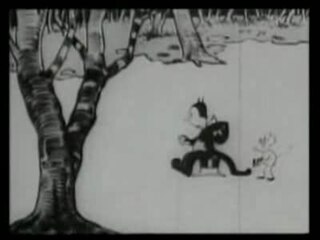
The Hearst-Vitagraph News Pictorial or Hearst-Vita graph was a short-lived company producing newsreels which were coupled with animated cartoons. It was established on 29 October 1915 by the Brooklyn-based Vitagraph Studios and the Hearst Corporation, and produced its first reel in February 1916, but folded in 1916. Previously, Hearst had produced newsreels together with the Selig Polyscope Company from 1914 on, and after the deal with Vitagraph ended Hearst teamed up with Pathé.
John Dirks was an American cartoonist and sculptor.
Joseph Musial was an American cartoonist who drew The Katzenjammer Kids from 1956 to his death in 1977.
The New York World was one of the first newspapers to publish comic strips, starting around 1890, and contributed greatly to the development of the American comic strip. Notable strips that originated with the World included Richard F. Outcault's Hogan's Alley, Rudolph Dirks' The Captain and the Kids, Denys Wortman's Everyday Movies, Fritzi Ritz, Gus Mager's Hawkshaw the Detective, Victor Forsythe's Joe Jinks, and Robert Moore Brinkerhoff's Little Mary Mixup.

Fabulous Funnies is a 1978–1979 American Saturday morning animated TV series produced by Filmation. The show aired for one season from September 9, 1978, to December 1, 1978, on NBC, airing 13 episodes.
